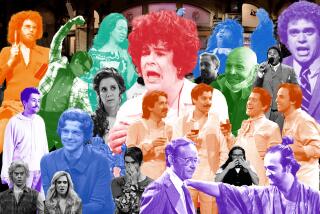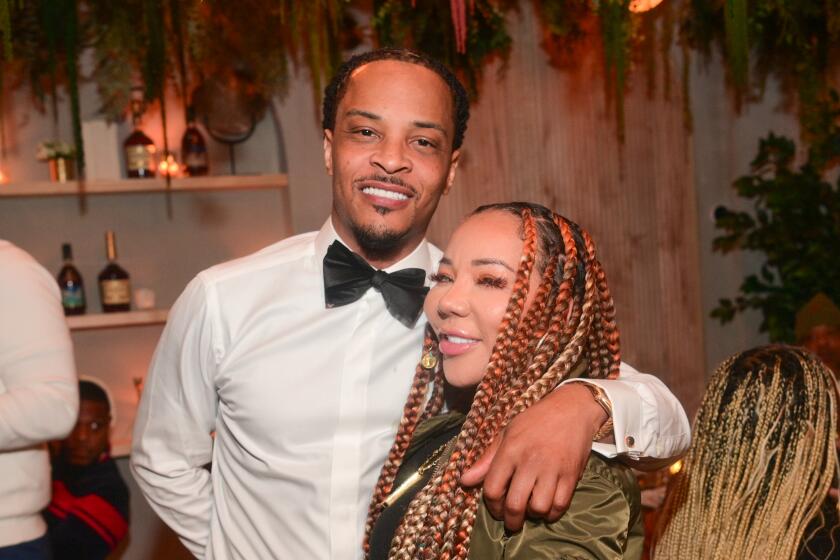Bringing the real L.A. to life
Los Angeles is home to an industry that makes dramas and exports them around the world. But there’s something wrong about the way our diverse city looks and sounds in big Hollywood films.
With a few, notable exceptions, Latinos are usually in the background, doing yardwork or working as nannies, putting on the thick Spanish accents demanded by their scripts.
Black characters are often wacky police officers, gangsters or single moms. Asians are technicians or immigrants who look confused. And the white characters are usually well-off and self-involved, fated to learn about the essential goodness of all the other ethnic groups.
It’s all so predictable and unsatisfying.
The real L.A. is a crazy cast of Shakespearean characters and tragicomic contradictions. Where can you find actors who bring that reality to life? In our small but vibrant community theater scene, of course.
Among many troupes, there’s the Company of Angels, the Robey Theatre Company, the Actors’ Gang in Culver City, and the legendary Cornerstone Theater Company.
L.A. is also blessed to have three actors with roots in comedy who are a Southern California institution. They aren’t afraid of offending anybody. And they feel free to let rip on stage with all the weirdness that makes L.A. a cool and confounding place to live.
Culture Clash will celebrate its 25th anniversary Oct. 30 at UCLA’s Royce Hall with a host of luminaries. If one word captures their oeuvre, it’s “fearlessness.” Over the years, Herbert Siguenza, Ric Salinas and Richard Montoya have portrayed just about every local “type” imaginable on stage.
Male and female, gay and straight. Accents with a touch of Yiddish, of Iowa, or Guatemala. Muslim and Jewish. In blond wigs, skullcaps or sombreros. Day laborers and mayors, or even the beloved Dodger announcer Vin Scully. These guys will work themselves into any skin. And they seem to find “the funny” and the true every time.
“We’re equal opportunity offenders,” Salinas told me.
To show the real L.A., you have to be.
“My friends back East and in San Francisco look at L.A. and see a laid-back, phony, plastic place,” Montoya added. “But this is really the biggest powder keg in the world. . . . It’s a multicultural theme park ride.”
Siguenza showed me a picture of the ash that covered his car that morning, and chimed in: “L.A.’s always on the brink of disaster.” One day the budget is collapsing, the next the mountains are ablaze. But where else can you find great kimchi and brain tacos just off the same freeway exit?
Pardon the alliteration, but capturing California craziness is Culture Clash’s specialty.
Their style is Mel Brooks meets Bertolt Brecht meets El Teatro Campesino. And it’s been shaped with the help of collaborators who include some of the best talents in American theater -- people like Bill Rauch of the Oregon Shakespeare Festival, who will direct their next play, an adaptation of the Greek playwright Aristophanes’ 2,500-year-old work “Peace.”
“Peace” opens Thursday at the Getty Villa’s 450-seat outdoor amphitheater in Malibu.
Culture Clash first performed together on a much, much smaller stage in San Francisco’s Mission District for a Cinco de Mayo show in 1984.
The 1980s, you may remember, was supposed to be “the Decade of the Hispanic.” The early Culture Clash mocked the empty promise of that marketing line -- and also the humor deficit of the Bay Area lefty Latino activists.
“The movement took itself really seriously and we were the clowns coming in,” Salinas remembers. “People got mad at us for making fun of Che Guevara and Frida Kahlo.”
Their Bay Area audiences grew, then suddenly shrank dramatically.
So in 1990 they moved to Southern California, where people were hungry for smart comedy about L.A.’s burgeoning Latino community.
“Los Angeles really changed things for us,” Salinas remembered. “There was a huge audience waiting for us here. . . . And our L.A. audience itself became a culture clash.”
In the 1991 “A Bowl of Beings” at the Los Angeles Theatre Center, they picked apart the Hollywood stereotypes, historical tragedies and obsessions associated with the Mexican American experience. The actors got big laughs by melodramatically repeating the line: “I’m a Chicano! I’m confused and full of rage!”
Since then they’ve branched out artistically, staging a couple of epics plays about L.A. history, including “Chavez Ravine.”
Along the way, they’ve also brought their characters -- struggling immigrants, Orange County suburbanites and black ministers -- to theaters where Latino actors rarely go.
“Peace” is one of Aristophanes’ raunchiest works, a satire of the leaders who dominated the Athens of his day.
The goddess Peace has been kidnapped by the evil ogre War.
Three farmers -- who in Culture Clash’s adaptation bear a striking resemblance to modern Californians -- fly to heaven to rescue her.
The farmers ride a dung beetle and “there’s a couple of statues made out of stuff you wouldn’t think statues are made of,” Montoya said.
I haven’t seen “Peace” yet. But I’ve been warned not to bring my children.
“Palestine, New Mexico” opens in December and next year they’ll premiere “American Night,” the opening work in the Oregon Shakespeare Festival’s “American Revolutions,” a 37-play series on U.S. history that will feature some of the country’s leading playwrights.
In “American Night,” an immigrant studies so hard for his U.S. citizenship test that he’s sent into a fever dream. He travels across time to the Oregon Trail, to Gettysburg and to Mexico, where he sees the signing of the treaty that surrenders California to the U.S.
“It’s about pursuing the American dream,” Siguenza explained, “at the cost of saying goodbye to something you know.”
Immigrants? U.S. history? American dreams? That sounds like a quintessential L.A. story to me.
--
More to Read
The biggest entertainment stories
Get our big stories about Hollywood, film, television, music, arts, culture and more right in your inbox as soon as they publish.
You may occasionally receive promotional content from the Los Angeles Times.











